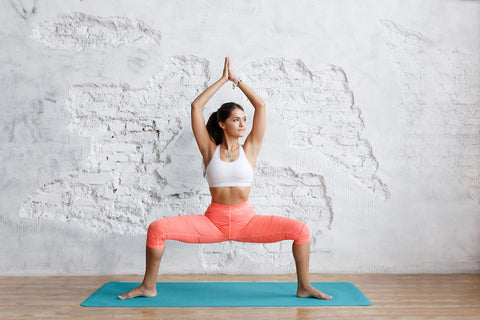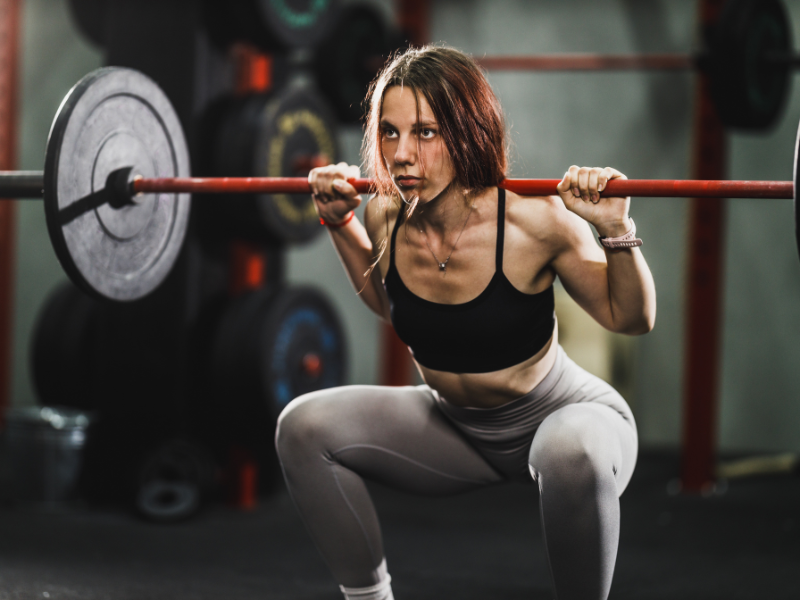Squats are a great lower body exercise, but which variation is best - sumo or regular?
Let's explore the key differences between these two squat types so you can pick the one that is best for you.
Understanding Sumo Squats

The sumo squat uses a wide stance with the feet turned out.
This targets the inner thighs and glutes more than a regular squat. The wider positioning reduces the range of motion versus a regular squat.
To do a sumo squat, stand under the barbell and position it across your traps. Take a wide stance, turn your toes out, and unrack the weight. Push the hips back and bend at the knees until the thighs are parallel to the ground.
Drive through the heels and back to the starting position.
Benefits of Sumo Squats
Sumo squats target the glutes and inner thighs more than traditional squats due to their wider stance. This makes them great for strengthening these areas. Their wide stance and upright torso allow for a shorter range of motion, enabling you to lift heavier loads.
This can accelerate strength gains, especially in the glutes.
In addition, the upright torso during sumo squats reduces lower back strain, potentially making them a safer choice for those with back concerns.
Exploring Regular Squats

The traditional squat uses a shoulder-width stance with toes facing forward. This stance enables a greater range of motion, allowing you to squat deeper than with a sumo squat.
Regular squats target the quadriceps muscles extensively.
To perform a regular squat, take a shoulder-width stance with toes facing forward. Stand under the barbell, position it across your traps, and unrack the weight. Send the hips back and bend at your knees until the thighs are parallel to the ground.
Then, drive back up to the starting position.
Benefits of Regular Squats
Regular squats, with their shoulder-width stance, enhance quad development due to the greater range of motion from the narrower stance.
This improves functional strength and mobility for daily activities.
Also, regular squats follow a more natural movement pattern, making them accessible for beginners or those new to training.
Major Muscle Groups Targeted by Sumo and Regular Squats
Sumo and regular squats are both excellent exercises for targeting major lower-body muscle groups, though they each emphasize different areas:
-
Quadriceps: Both squat variations actively engage the quadriceps, the large muscles at the front of your thighs. These muscles are crucial for knee extension.
-
Glutes: The glutes are also activated in both regular and sumo squats. However, the wider stance of the sumo squat recruits the glutes to a greater degree, providing a highly effective glute workout.
-
Hamstrings: These muscles at the back of your thighs are involved in both squat types to help control the descent and assist in standing back up.
-
Adductors: Sumo squats, with their wider stance, are particularly effective at recruiting the adductor muscles of the inner thigh muscles. These muscles are important for hip stability and leg adduction.
-
Core Muscles: Both squat variations engage the muscles of the core, which include the abs, obliques, and lower back. These muscles work in tandem to maintain balance and keep the torso upright during the squat motion.
How to Incorporate Both Squat Variations Into Your Workout Routine
Doing both sumo and regular squats provides a comprehensive lower-body workout.
You can alternate between them each session to switch your focus.
For example, do sumo squats for high-rep, endurance training, and regular squats for low-rep, strength building.
Or vary your stance width within a workout, doing wide-stance sumo squats followed by narrow-stance regular squats to challenge different muscles and enhance overall lower body strength.
Frequently Asked Questions
What is the main difference between a sumo squat and a regular squat?
A sumo squat uses a much wider stance with toes turned out, while a regular squat uses shoulder-width feet with toes slightly forward. This change in stance shifts the muscle focus and how your hips move.
Which muscles do sumo squats work better than regular squats?
Sumo squats place more emphasis on the inner thighs, glutes, and adductors. The wider stance reduces quad dominance and targets the muscles of the inner leg more effectively.
Which muscles do regular squats work better than sumo squats?
Regular squats hit the quads, glutes, and core more evenly and are better for overall leg strength. They also require more ankle mobility and deeper knee flexion.
Are sumo squats better for people with hip or lower back issues?
Sumo squats can feel more comfortable for some people because the wider stance reduces forward lean and may lessen lower back stress. They can also help people who struggle to hit depth in a regular squat.
Should I do sumo squats or regular squats if I want to build bigger legs?
For general leg size and strength, regular squats are the best primary choice. Adding sumo squats as an accessory movement can help improve inner thigh and glute development.
How do sumo and regular squats impact muscle growth and strength?
Both sumo and regular squats build muscle and strength but target your lower body differently. Regular squats’ shoulder-width stance emphasizes the quads, while sumo squats’ wide stance hits the glutes and inner thighs more. However, both work the hamstrings equally. For full lower body development, alternate between sumo and regular squats and challenge all your muscles.
Which squat variation is better for beginners?
If you're new to squats, start with regular, shoulder-width stance squats. They require less hip and ankle mobility and mimic functional, everyday motions like sitting down and standing up. After mastering regular squats with light weight, add sumo squats for variety. Just remember, sumo squats need more hip flexibility, so warm up your hips properly before attempting heavier loads.
How can diet enhance the results of squat exercises?
For effective muscle growth from squats, get enough protein, carbohydrates, and overall calories in your diet. Protein powder can give your muscles the amino acids they need to repair and grow after squat sessions, while carbs provide the fuel for intense workouts. Make sure your total calories align with your goals, whether it's gaining muscle or leaning out. Getting sufficient healthy calories helps your body build new muscle tissue after you've challenged it with squats.













































































Share:
Unveiling the Truth: Can Creatine Monohydrate Go Bad?
Revealed: How to Get a Bigger Booty and Thighs